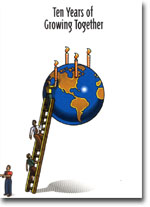
Shaping A Culture
Ten Years Of Growing Together - 1995 - AT&T Capital Corporation
If there's a certain romance to the story of the early days of AT&T Capital Corporation, then it's a romance deeply rooted in reality, with a straightforward business sense and a solid understanding of the way the world works. Without that understanding, the whole exercise might have remained just another curiosity, one more innovative managerial theory that ultimately failed its field test.
In it first five years, the company not only passed the field test; it did so in record time and with record results. Between 1985 and 1990, the company increased it assets, revenues, net income and the number of customer accounts. In those five years, the number of members exploded from fewer than 20 in 1985 to more than 2,000.
In explaining her desire to be the team charged with the merger of high and low volume, one member cited this dramatic growth as the deciding factor: "I was the 22nd person hired, but the company grew so fast that I lost the feeling that this was mine."
Today, just as it did with the merger and the redesign of the high-volume business before that, the company continues regularly to re-examine its basic vision - clearheaded, realistic, but also something more.
The company that Tom Wajnert now calls "a learning organization" started with a vision of the possibilities and as an exercise in semantics. The evolution began by seeing the opportunities that were already there and redefining the existing terminology.
Paul Gustavson observes, "There's a proven relationship between language and change, because words conjure up new images and a new way of looking at things. Consider, for example, the word perestroika and the effect that had in Russia. To create a new culture, you have to create a new language."
To create this new culture at AT&T Capital, the language of management had to change: The corporation became a principle-based learning organization. Departments change and became self-managed teams. Titles became meaningless: Managers grew into leaders; employees were transformed into members.
Paul Gustavson: "Tom Wajnert wanted to minimize the status differential between people and groups in the organization. If you create difference - say, between management and non-management - then you have to manage them, energy that would probably be better used serving the customer."
So they chose the word "member" instead of "employee". In the new company, there would be no management, no employees, no us, no them - there would only be team members.
This article was featured in Ten Years of Growing Together. Through language first, then through action, the game was opened up to anyone who wanted to play, and that has always been the great secret of the company's success.
"Just about everyone in a learning organization is a potential leader, " Tom says. "The organization nurtures the leader, and the leader nurtures the organization - and its principles - in an unbreakable circle that will never end."
After a while, the words began to take on believability and weight. The company turned unto what t said it wanted to be. The vision became a living process. And the circle kept growing.
"We didn't do this for the purpose of having an advanced cultural design, or being faddish," Tom says. "We did it because we wanted to be successful." For all its astonishing financial success, the company's culture may be AT&T Capital's most important and lasting legacy: an accomplishment all the more unique because it goes against much of what is commonplace in American corporate life.
"You have to remember that this kind of organization was unheard of in the financial industry when we started," Paul says. "And to a great degree, it still is. The industry is essentially a caste system and not easily changed. The power brokers are always at the top because that's where the money and the glory are. When they have to give that up, we call it 'ego death,' and they don't want any part of it."
It was not - and is not- always a smooth transition. But it was never an impossible one.
It is, in the final analysis, simply a better - though not necessarily easier or in all ways perfect - method for getting where you want to go. The critical corollary has always been: if you're willing to take the risk.
Tom Wajnert: "The toughest step toward becoming a learning organization is to be ready to truly learn what you are today and that you want to be tomorrow. And remember - once you start the process, you can't quit. As the sage said: 'If you start dancing with the bear, you can't stop when you're tired,'"


